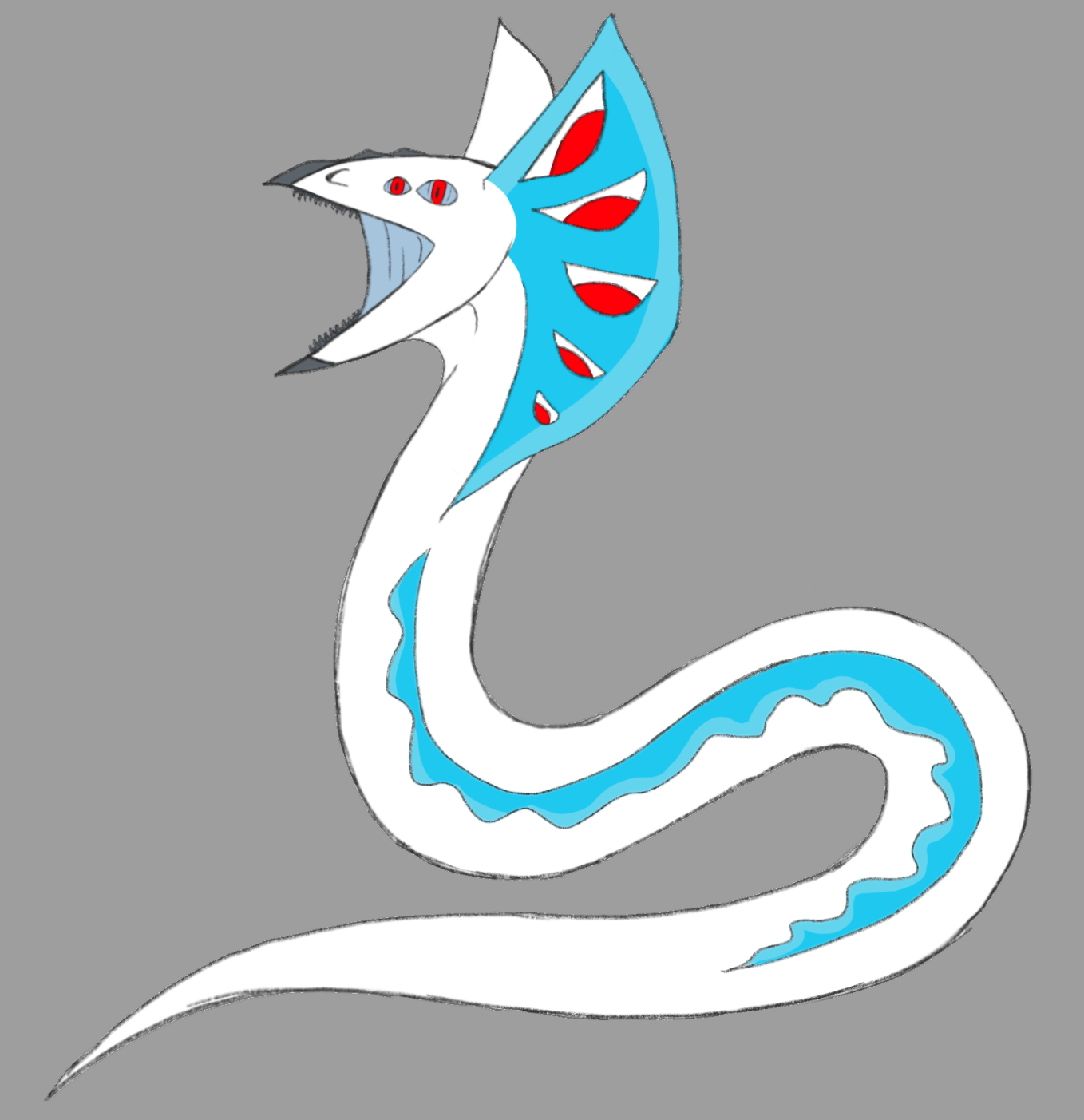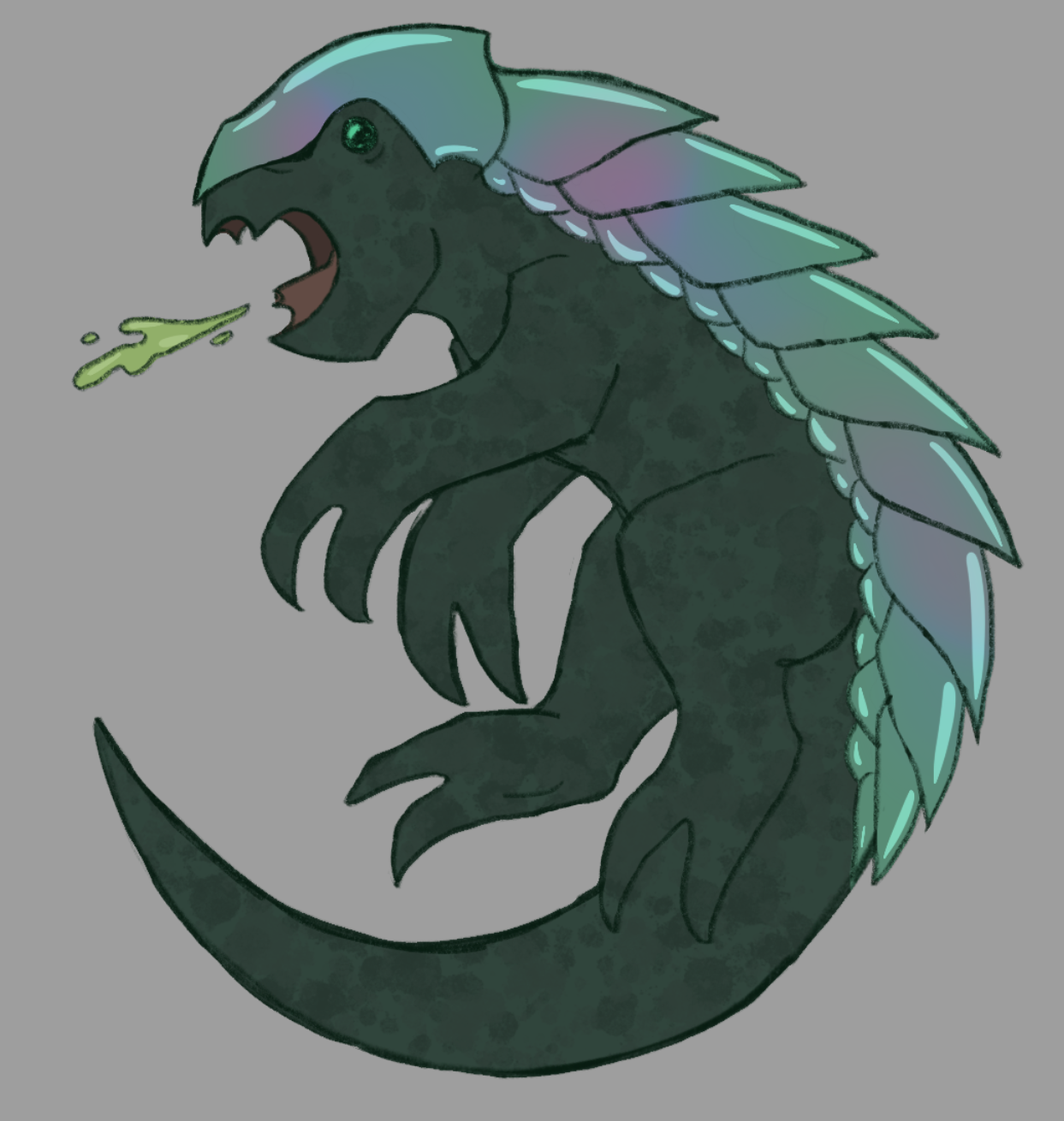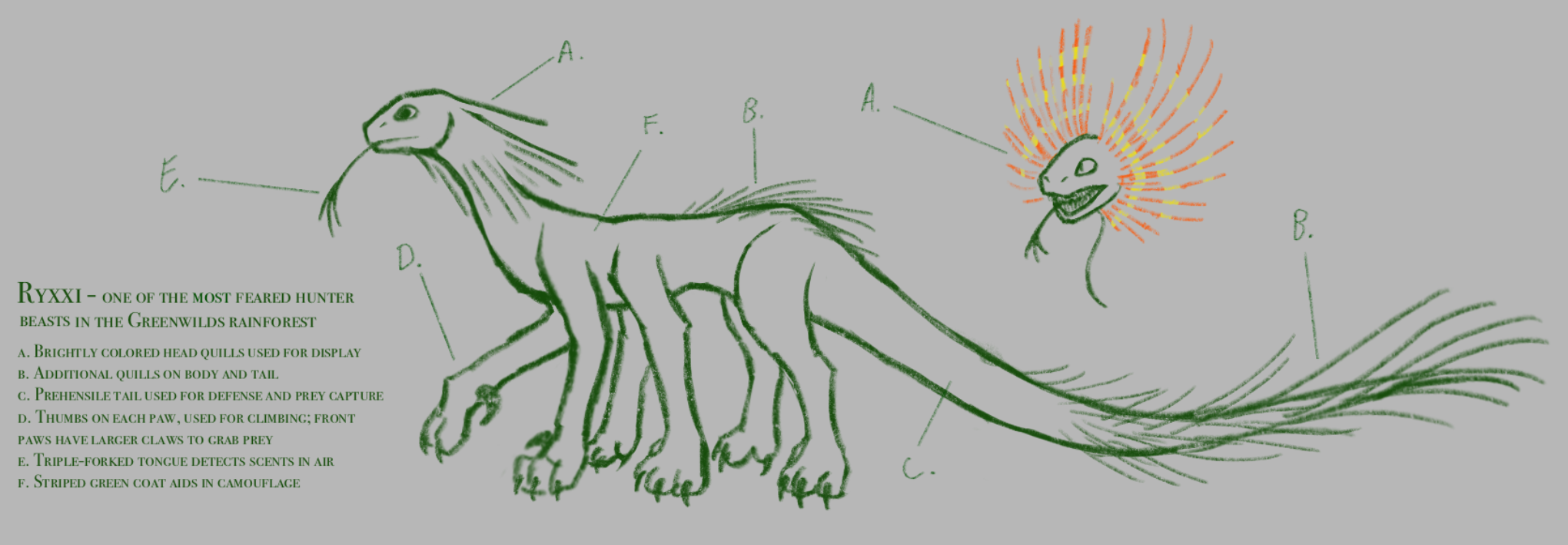Hunter Beasts
The Hunter class is a group of Terridean animals characterized by their carnivorous diet and being generally dangerous and/or aggressive towards tagarou and ally-beasts. These beasts are predators, actively killing prey-beasts for food, and will sometimes go after tagarou if prey is scarce.
Ryxxi

Regarded as the most fearsome predator in the Greenwilds rainforest, ryxxi (ryxxi, pronounced ricks-ee) are massive reptilian beasts that can grow up to 20 feet long. Their bodies are covered in smooth scales, with a “mane” of quills running down their backs and covering their entire tails. In addition to helping them blend into the foliage of their home, these spines are used as both an attack and defense mechanism against challengers.
Built to maneuver through both underbrush and trees, ryxxi have six muscular legs tipped with paw-like clawed feet. Their frontmost set of paws have an extra “thumb” spike that aids in grabbing prey and climbing trees and cliffs. Ryxxi teeth are interesting in structure; they curve backwards, and can move similarly to switchblades: when the mouth is closed, the teeth rotate up into the jawbone, and flip outwards when needed. Like many lizards from Earth, ryxxi have forked tongues used for picking up scents in the air. Rather than two tips, however, their tongues actually have three, giving them a trident-like shape.
Despite their imposing appearance and reputation, ryxxi do not attack non-prey animals- including tagarou- unless provoked. When agitated, ryxxi will raise the mane of quills around their neck, similar to the ruff of a frilled lizard, to serve as a warning. This "frill" is brightly colored, with orange and yellow streaks that can easily be confused as a jungle flower at a glance. Both the frill and body quills can also be used to make a disquieting rattling noise for further intimidation.
Ryxxi - one of the most feared hunter beasts in the Greenwilds rainforest
- Brightly colored head quills used for display
- Additional quills on body and tail
- Prehensile tail used for defense and prey capture
- Thumbs on each paw, used for climbing; front paws have larger claws to grab prey
- Triple-forked tongue detects scents in air
- Striped (*patterned) coat aids in camouflage
Greater Sandweaver



Greater Sandweaver subtypes from the Red Desert, Starsands, and Goldsands respectively.
Named for the up-and-down motion they use to “swim” beneath the surface of the desert sand, greater sandweavers are a lone traveler’s worst nightmare. Found in all three of Terridea’s major desert regions, these carnivorous beasts can grow between 30 to 40 feet in length, with coloration and markings to match their environment.
Sandweavers have long, undulating fins along both sides of their bodies, which help them burrow through the sand at high speeds. In addition to this, greater sandweavers possess cobra-like flaps on their necks that they use for intimidation, communication, and attracting mates. When not in use, the flaps press flat against their sides. Alongside being their most prominent feature, this is also a greater sandweaver’s weak spot; shooting any piercing projectile, like a bullet or arrow, into one of their fins will disorient the sandweaver and cause it to retreat.
Lesser Sandweaver

Lesser Sandweaver subtypes from the Red Desert, Starsands, and Goldsands respectively.
The smaller cousin of the greater sandweaver, only growing up to about 10 feet long, lesser sandweavers are still a notable danger to those traveling the deserts of Terridea. These snake-like hunters travel in packs, jumping in and out of the dunes like dolphins as they burrow. Though they lack the impressive frills of their larger counterparts, they have no need to intimidate prey; they can easily swarm and overtake their targets in minutes. While a force to be reckoned with in groups, lone sandweavers are much more vulnerable and tend to flee from larger enemies in most cases.
In addition to their fins and streamlined shape, sandweavers’ eyes are also adapted for traveling underground. Their eyelids are horizontal, originating from the sides of their eyes rather than the top and bottom. This prevents most sand from getting into their eyes as they burrow, as they keep their eyes tightly shut unless above the surface. Sandweavers mainly “see” by sensing vibrations around them, only using their actual eyes to lock onto prey above ground. Going from complete darkness to blinding brightness causes their pupils to rapidly contract, the sudden flash of their brightly colored irises serving to further instill fear in their targets.
Teya-Teyo

Color sketch of a teya-teyo
Though small in size (only about two feet long when fully grown), teya-teyo (teya-teyo) are not beasts to be trifled with. Their saliva is highly poisonous and corrosive, able to burn off layers of skin and flesh upon contact. On top of this defense mechanism, they possess blade-like claws and a strong beak that can easily slice through flesh and even snap bones.
The iridescent back plates of teya-teyo are a coveted resource for Wetlands tagarou. Used for both aesthetic and functional purposes, these plates are used in armor, jewelry, accessories, and sometimes even weaponry. However, due to their strength and the danger posed by confronting teya-teyo, these can be a difficult resource to obtain. In most cases, they are harvested from teya-teyo carcasses when the beasts either die of natural causes or are killed by other hunter-class species. As the meat of the animal is bitter and gamey, once the plates are removed, the rest of the carcass is left for other creatures to consume.
TBN

- Developed forearms with dextrous hands and needle-sharp, semi-retractable claws; kept close to the body when swimming
- Claws on front edges of flippers, aid in hydrodynamics and defense
- Tri-finned tail and multiple sets of flippers for agility and speed
- Gills along ribcage
- Barbed tongue shoots out like a frog's, acts as a harpoon
- Less armored than other species in its family, with only a few jagged, bladelike fins along its spine
- Two rows of sensory "quills" along back, detects movement in the water around it
An aquatic relative of the ryxxi, this beast is part of a major family of hunter beasts classified by their reptillian appearance, six limbs, and the presence armored plates and/or spikes along their backs.
